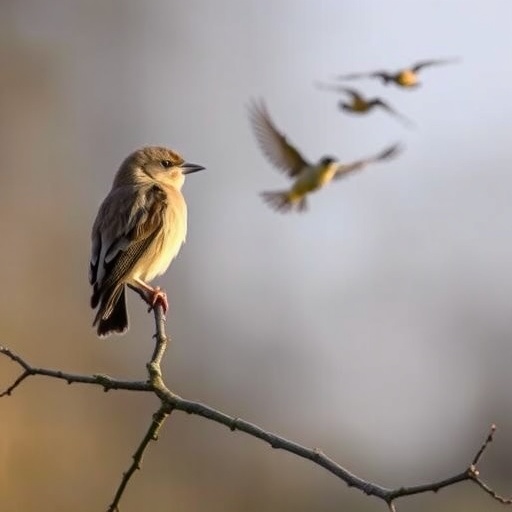In the ever-intensifying struggle faced by wildlife amidst expanding human impact, a new dimension has emerged, underscoring the subtle yet profound effects of anthropogenic noise on vulnerable species. Researchers at Flinders University have unveiled compelling evidence suggesting that traffic noise significantly compromises the territorial defense behaviors of the Southern Emu-wren (Stipiturus malachurus), a diminutive and threatened songbird endemic to southern Australia. This revelation illuminates an underappreciated ecological pressure, raising concerns about the broader implications of human-generated soundscapes on avian populations.
The Southern Emu-wren, among Australia’s smallest birds, is emblematic of the delicate balance between wildlife and the accelerating urban and agricultural modifications of their habitats. The pervasive intrusion of traffic noise—a byproduct of modern infrastructure—emerges as a disruptive force in the acoustic environment critical for avian communication. This study, led by PhD candidate Julian Behrens at Flinders BirdLab, is pioneering in its approach to quantify how noise pollution disturbs the natural behaviors that are essential for survival and reproduction in this species.
Traffic noise primarily interferes with the birds’ ability to communicate through song, which is integral not only in mate attraction but also in the defense of territories against rival males. The research meticulously evaluated the responses of four Southern Emu-wren subspecies inhabiting diverse ecological regions, from the semi-urban Mount Lofty Ranges near Adelaide to the more isolated areas of the Coorong, Eyre Peninsula, and Kangaroo Island. The study systematically exposed individuals to controlled traffic noise simulations to observe alterations in their signaling and defensive strategies.
Data analysis revealed that exposure to short-term traffic noise significantly diminishes the efficacy of the birds’ territorial defense. The noise masks critical acoustic cues, resulting in attenuated vocalizations and a decrease in territorial aggressiveness. Such muted responses not only compromise the birds’ immediate ability to repel intruders but may also cascade into reduced breeding success and altered social dynamics within populations. These findings align with a growing body of international research highlighting the insidious consequences of noise pollution on wildlife communication networks.
Senior lecturer Dr. Diane Colombelli-Négrel, a specialist in animal behavior and director of BirdLab, stresses the conservation ramifications of these results. She explains that when birds’ signaling is hindered, their capacity to secure and maintain territories—a determinant of access to resources and mates—is fundamentally undermined. This disruption poses a tangible threat to their fitness and survival prospects, particularly for species with restricted ranges and specialized habitat requirements such as the Southern Emu-wren.
Simultaneously, the lead author’s collaborators have extended their ecological investigations to another biodiverse yet sensitive environment—the Galápagos Islands. Under the stewardship of Professor Sonia Kleindorfer, research on invertebrate communities across Floreana Island has illustrated the profound impacts of intensive land use and climate stressors on biodiversity. Their extensive specimen collection, encompassing over 15,000 invertebrates across multiple taxa, reveals stark contrasts between protected national park areas and adjacent agricultural landscapes, with notable declines in species richness and abundance linked to anthropogenic disturbance.
Professor Kleindorfer’s longitudinal work, spanning Australia and the Galápagos archipelago, reinforces the global pattern where intensifying human pressures contribute to biodiversity loss, especially on islands that are hotspots of endemism yet vulnerable to extinction. The integrative approach of assessing both vertebrate and invertebrate responses strengthens the conceptual framework for understanding ecosystem resilience and guides targeted strategies for conservation management.
The synthesis of these studies is critically timed amid escalating concerns about the cumulative effects of habitat fragmentation, invasive species, and now acoustic pollution on wildlife. The new research on the Southern Emu-wren encapsulates a nuanced ecological challenge: anthropogenic noise pollution poses an invisible barrier in the lives of territorial songbirds, altering behaviors that have evolved over millennia. Considering that bird song is a primary modality for reproductive success, diminished signaling under noise stress could accelerate population declines from which recovery might be difficult.
Importantly, this body of work exemplifies the value of experimental field studies employing acoustic manipulations to discern causative relationships in complex natural settings. By leveraging observational methodologies complemented by controlled noise exposures, the researchers elucidate mechanistic pathways linking environmental disturbances to behavioral and ecological outcomes. Such evidence is paramount for informing policymakers and land managers tasked with mitigating anthropogenic impacts on wildlife.
The findings mandate enhanced awareness of how urban expansion and infrastructural development must account for the acoustic footprint left on ecosystems. Mitigation strategies could incorporate noise-reducing technologies, designated quiet zones, or habitat buffers that shield critical avian population centers from relentless traffic sounds. These interventions, grounded in empirical research, offer hope for balancing human activity with the preservation of biodiversity.
The importance of communication in social and reproductive contexts for birds underlines the emerging recognition of sensory ecology as a critical dimension in conservation science. Traffic noise, by obscuring acoustic signals, inadvertently rewires ecological interactions and threatens the evolutionary viability of vulnerable species. Conservation efforts must increasingly integrate soundscape considerations alongside traditional habitat and population management.
This research, published in the International Journal of Avian Science, establishes a precedent for further multidisciplinary investigations into how varied anthropogenic stressors intersect to challenge wildlife resilience. It also highlights the role of collaborative international research, as insights from Australian songbirds and Galápagos invertebrates converge to paint a comprehensive portrait of environmental change.
Through combining detailed field observations, rigorous experimental design, and cross-ecosystem comparisons, this suite of studies redefines our understanding of anthropogenic influence, moving beyond visible impacts to probe the acoustic and ecological subtleties threatening biodiversity. The Southern Emu-wren’s story serves as a clarion call urging science, policy, and society to embrace more holistic and nuanced approaches for the stewardship of natural systems in a noisy world.
Subject of Research: Animals
Article Title: Exposure to traffic noise weakens territory defence in the Southern Emu-wren (Stipiturus malachurus)
News Publication Date: 2-Sep-2025
Web References:
https://onlinelibrary.wiley.com/doi/10.1111/ibi.13445
https://link.springer.com/article/10.1007/s10841-025-00705-4
References:
Behrens, J., Colombelli-Négrel, D., & Kleindorfer, S. (2025). Exposure to traffic noise weakens territory defence in the Southern Emu-wren (Stipiturus malachurus). International Journal of Avian Science. DOI: 10.1111/ibi.13445
Common, L., et al. (2025). Invertebrate abundance and diversity in agricultural and national park areas on Floreana Island, Galápagos. Journal of Insect Conservation. DOI: 10.1007/s10841-025-00705-4
Image Credits: Julian Behrens (Flinders University)
Keywords: Southern Emu-wren, traffic noise, anthropogenic noise, territory defence, bird communication, acoustic pollution, biodiversity conservation, invasive species, Galápagos invertebrates, sensory ecology, habitat disturbance, avian behavior
Tags: anthropogenic noise effects on wildlifeavian behavior and urban environmentsconservation challenges for songbirdsecological pressures on avian speciesendangered Australian bird speciesFlinders University wildlife researchhabitat modification and songbirdsimplications of soundscapes on ecosystemsnoise pollution and territorial defenseSouthern Emu-wren survival threatstraffic noise impact on birdsurbanization and bird communication


